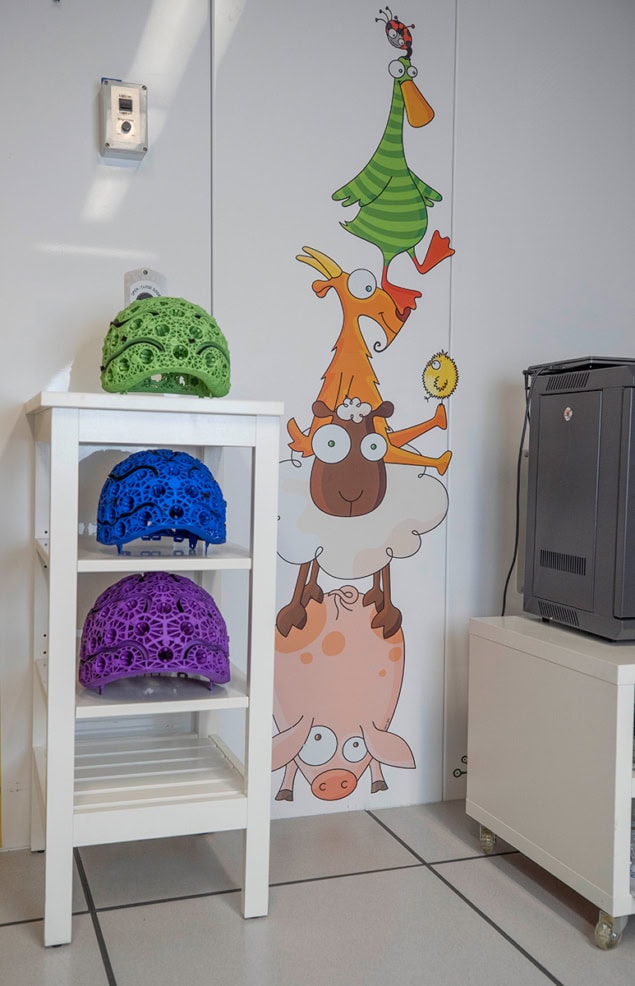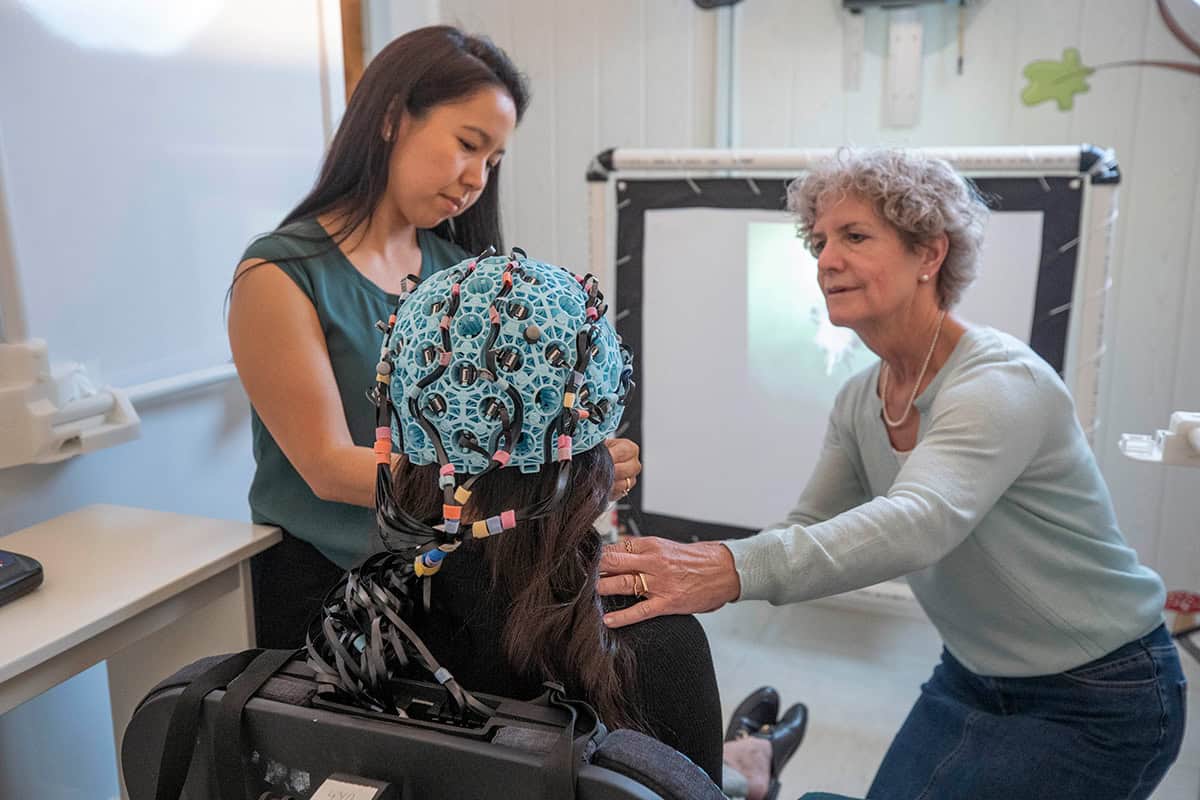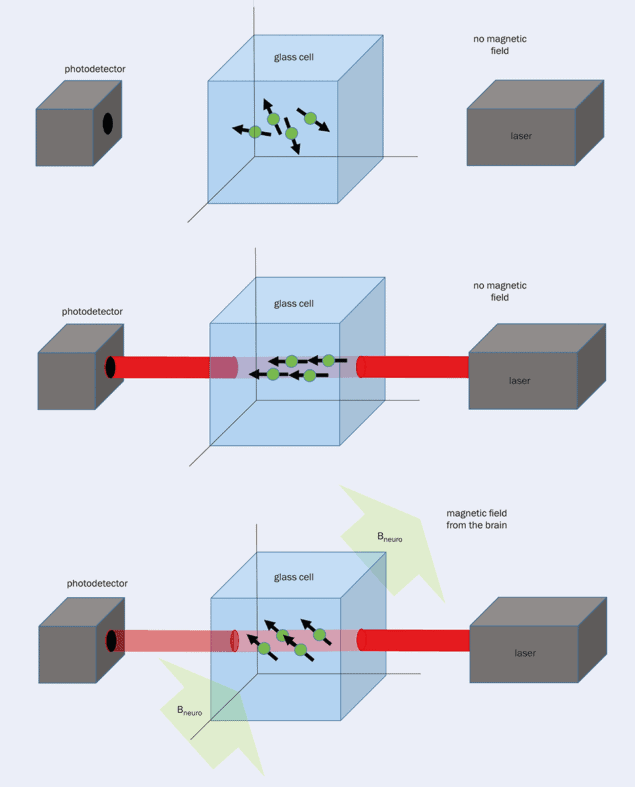Though she isn’t a physicist or an engineer, Margot Taylor has spent much of her career studying electrical circuits. As the director of functional neuroimaging at the Hospital for Sick Children in Toronto, Canada, Taylor has dedicated her research to the most complex electrochemical device on the planet – the human brain.
Taylor uses various brain imaging techniques including MRI to understand cognitive development in children. One of her current projects uses a novel quantum sensing technology to map electrical brain activity. Magnetoencephalography with optically pumped magnetometry (OPM-MEG) is a wearable technology that uses quantum spins to localize electrical impulses coming from different regions of the brain.
Physics World’s Hamish Johnston caught up with Taylor to discover why OPM-MEG could be a breakthrough for studying children, and how she’s using it to understand the differences between autistic and non-autistic people.
The OPM-MEG helmets Taylor uses in this research were developed by Cerca Magnetics, a company founded in 2020 as a spin-out from the University of Nottingham‘s Sir Peter Mansfield Imaging Centre in the UK. Johnston also spoke to Cerca’s chief executive David Woolger, who explained how the technology works and what other applications they are developing.
Margot Taylor: understanding the brain
What is magnetoencephalography, and how is it used in medicine?
Magnetoencephalography (MEG) is the most sensitive non-invasive means we have of assessing brain function. Specifically, the technique gives us information about electrical activity in the brain. It doesn’t give us any information about the structure of the brain, but the disorders that I’m interested in are disorders of brain function, rather than disorders of brain structure. There are some other techniques, but MEG gives us amazing temporal and spatial resolution, which makes it very valuable.
So you’re measuring electrical signals. Does that mean that the brain is essentially an electrical device?
Indeed, they are hugely complex, electrical devices. Technically it’s electrochemical, but we are measuring the electrical signals that are the product of the electrochemical reactions in the brain.
When you perform MEG, how do you know where that signal’s coming from?
We usually get a structural MRI as well, and then we have very good source localization approaches so that we can tell exactly where in the brain different signals are coming from. We can also get information about how the signals are connecting with each other, the interactions among different brain regions, and the timing of those interactions.

Why does quantum MEG make it easier to do brain scans on children?
The quantum technology is called optically pumped magnetometry (OPM) and it’s a wearable system, where the sensors are placed in a helmet. This means there is allowed movement because the helmet moves with the child. We’re able to record brain signals in very young children because they can move or sit on their parents’ laps, they don’t have to be lying perfectly still.
Conventional MEG uses cryogenic technology and is typically one size fits all. It’s designed for an adult male head and if you put in a small child, their head is a long way from the sensors. With OPM, however, the helmet can be adapted for different sized heads. We have little tiny helmets up to bigger helmets. This is a game changer in terms of recording signals in little children.
Can you tell us more about the study you’re leading at the Hospital for Sick Children in Toronto using a quantum MEG system from the UK’s Cerca Magnetics?
We are looking at early brain function in autistic and non-autistic children. Autism is usually diagnosed by about three years of age, although sometimes it’s not diagnosed until they’re older. But if a child could be diagnosed with autism earlier, then interventions could start earlier. And so we’re looking at autistic and non-autistic children as well as children that have a high likelihood of being autistic to see if we can get brain signals that will predict whether they will go on to get a diagnosis or not.
How do the responses you measure using quantum MEG differ between autistic and non-autistic people, or those with a high likelihood of developing autism?
We don’t have that data yet because we’re looking at the children who have a high likelihood of being autistic, so we have to wait until they grow up and for another year or so to see if they get a diagnosis. For the children who do have a diagnosis of autism already, it seems like the responses are atypical, but we haven’t fully analysed that data. We think that there is a signal there that we’ll be able to report in the foreseeable future, but we have only tested 32 autistic children so far, and we’d like to get more data before we publish.

Do you have any preliminary results or published papers based on this data yet?
We’re still analysing data. We’re seeing beautiful, age-related changes in our cohort of non-autistic children. Because nobody has been able to do these studies before, we have to establish the foundational datasets with non-autistic children before we can compare it to autistic children or children who have a high likelihood of being autistic. And those will be published very shortly.
Are you using the quantum MEG system for anything else at the moment?
With the OPM system, we’re also setting up studies looking at children with epilepsy. We want to compare the OPM technology with the cryogenic MEG and other imaging technologies and we’re working with our colleagues to do that. We’re also looking at children who have a known genetic disorder to see if they have brain signals that predict whether they will also go on to experience a neurodevelopmental disorder. We’re also looking at children who are born to mothers with HIV to see if we can get an indication of what is happening in their brains that may affect their later development.
David Woolger: expanding applications
Can you give us a brief description of Cerca Magnetics’ technology and how it works?
When a neuron fires, you get an electrical current and a corresponding magnetic field. Our technology uses optically pumped magnetometers (OPMs), which are very sensitive to magnetic fields. Effectively, we’re sensing magnetic fields 500 million times lower than the Earth’s magnetic field.
To enable us to do that, as well as the quantum sensors, we need to shield against the Earth’s magnetic field, so we do this in a shielded environment with both active and passive shielding. We are then able to measure the magnetic fields from the brain, which we can use to understand functionally what’s going on in that area.
Are there any other applications for this technology beyond your work with Margot Taylor?
There’s a vast number of applications within the field of brain health. For example, we’re working with a team in Oxford at the moment, looking at dementia. So that’s at the other end of the life cycle, studying ways to identify the disease much earlier. If you can do that you can potentially start treatment with drugs or other interventions earlier.
Outside brain health, there are a number of groups who are using this quantum technology in other areas of medical science. One group in Arkansas is looking at foetal imaging during pregnancy, using it to see much more clearly than has previously been possible.
There’s another group in London looking at spinal imaging using OPM. Concussion is another potential application of these sensors, for sports or military injuries. There’s a vast range of medical-imaging applications that can be done with these sensors.
Have you looked at non-medical applications?
Cerca is very much a medical-imaging company, but I am aware of other applications of the technology. For example, applications with car batteries have potential to be a big market. When they make car batteries, there’s a lot of electrochemistry that goes into the cells. If you can image those processes during production, you can effectively optimize that production cycle, and therefore reduce the costs of the batteries. This has a real potential benefit for use in electric cars.
What’s next for Cerca Magnetics’ technology?
We are in a good position in that we’ve been able to deliver our initial systems to the research market and actually earn revenue. We have made a profit every year since we started trading. We have then reinvested that profit back into further development. For example, we are looking at scanning two people at once, looking at other techniques that will continue to develop the product, and most importantly, working on medical device approval. At the moment, our system is only sold to research institutes, but we believe that if the product were available in every hospital and every doctor’s surgery, it could have an incredible societal impact across the human lifespan.
Magnetoencephalography with optically pumped magnetometers

Like any electrical current, signals transmitted by neurons in the brain generate magnetic fields. Magnetoencephalography (MEG) is an imaging technique that detects these signals and locates them in the brain. MEG has been used to plan brain surgery to treat epilepsy. It is also being developed as a diagnostic tool for disorders including schizophrenia and Alzheimer’s disease.
MEG traditionally uses superconducting quantum interference devices (SQUIDs), which are sensitive to very small magnetic fields. However, SQUIDs must be cryogenically cooled, which makes the technology bulky and immobile. Magnetoencephalography with optically pumped magnetometers (OPM-MEG) is an alternative technology that operates at room temperature. Optically pumped magnetometers (OPMs) are small quantum devices that can be integrated into a helmet, which is an advantage for imaging children’s brains.
The key components of an OPM device are a cloud of alkali atoms (generally rubidium), a laser and a photodetector. Initially, the spins of the atoms point in random directions (top row in figure), but applying a polarized laser of the correct frequency aligns the spins along the direction of the light (middle row in figure). When the atoms are in this state, they are transparent to the laser so the signal reaching the photodetector is at a maximum.
However, in the presence of a magnetic field, such as that from a brain wave, the spins of the atoms are perturbed and they are no longer aligned with the laser (bottom row in figure). The atoms can now absorb some of the laser light, which reduces the signal reaching the photodetector.
In OPM-MEG, these devices are placed around the patient’s head and integrated into a helmet. By measuring the signal from the devices and combining this with structural images and computer modelling, it’s possible to work out where in the brain the signal came from. This can be used to understand how electrical activity in different brain regions is linked to development, brain disorders and neurodivergence.
The post Quantum brainwave: using wearable quantum technology to study cognitive development appeared first on Physics World.

